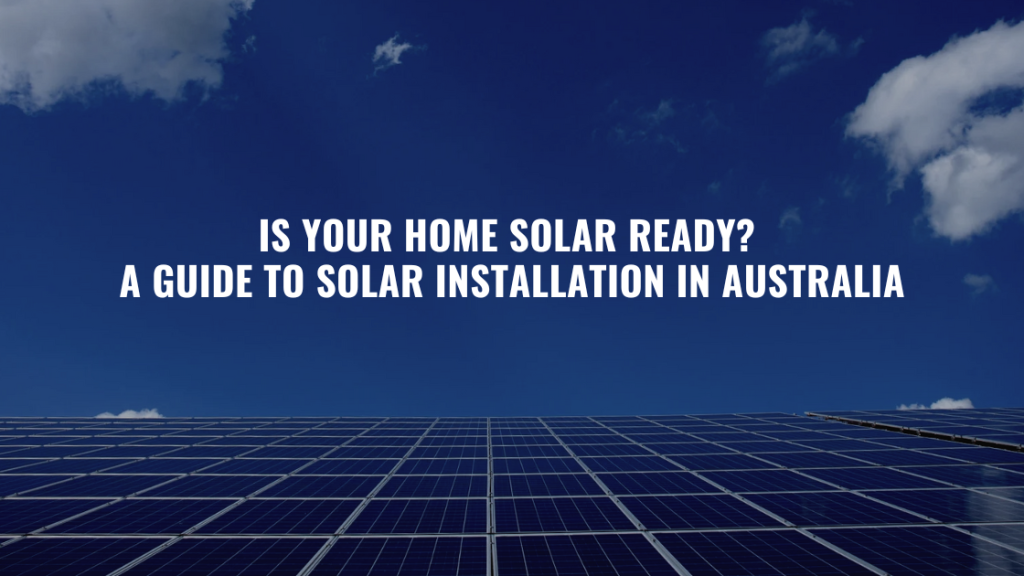As energy costs rise and environmental awareness grows, many Australian homeowners are looking to switch to solar energy. It’s a powerful step toward reducing electricity bills, decreasing carbon footprints, and achieving a measure of energy independence. However, before you dive into solar, it’s essential to determine if your home is “solar-ready.” In this guide, we’ll walk you through what to check to ensure your property is suitable for solar installation and help you make an informed decision.
Table of Contents
Toggle1. Assess Your Roof’s Condition and Structure
Your roof is the foundation of a successful solar installation. Here’s what to consider:- Roof Age and Condition: Since solar panels typically last 25+ years, it’s best to install them on a roof that won’t require significant repairs or replacement soon. If your roof is older or damaged, it’s wise to address those issues first to avoid needing to dismantle and reinstall the panels later.
- Roof Material: Common Australian roofing materials like tile, metal, and concrete generally support solar installations. However, materials like slate or wood might require special mounts, increasing installation complexity and cost.
- Orientation and Tilt: The best orientation for solar panels in Australia is generally north-facing to capture maximum sunlight throughout the day. While a roof tilt angle between 15-30 degrees is ideal, adjustments can be made with mounting equipment if your roof’s angle is outside this range.
2. Evaluate Your Sunlight Exposure and Shading
Solar panels need ample sunlight to perform optimally. Shade from trees, neighboring buildings, or chimneys can reduce their efficiency, especially if shadows fall on the panels during peak sun hours. Here’s how to assess sunlight exposure:- Shading Analysis: It’s helpful to conduct a shading analysis for your roof, which will show you how much shade different areas of your roof experience throughout the day. Solar providers often use tools to map shade and suggest the most effective layout for your panels.
- Seasonal Sunlight Variations: Solar panels generate more power in the summer due to longer daylight hours. However, cloudy and rainy days are common in some Australian regions, so it’s wise to review your area’s solar potential, which can be obtained from online resources like the Australian Bureau of Meteorology.
3. Check Your Energy Consumption Patterns
Understanding your household’s energy needs can help you choose an appropriately sized solar system. Reviewing your past electricity bills is a good starting point. Here are some tips to guide your assessment:- Identify Peak Usage: Determine when your household consumes the most energy. If your primary usage happens during the day, you’re in an excellent position to use more solar-generated power and rely less on the grid.
- Estimate System Size: The average Australian household might require a 5-6 kW system to cover daily energy consumption, but this depends on usage, family size, and appliance types. A solar provider can help recommend the best system size based on your needs and roof space.
4. Consider Local Climate and Solar Efficiency
Australia has a variety of climates, from tropical in the north to temperate in the south, impacting how much power solar systems can generate. Here are some factors to bear in mind:- Temperature Impact on Panels: While solar panels thrive in sunlight, extreme heat can decrease their efficiency. Panels often operate best at cooler temperatures, so if you live in a very hot region, it’s essential to discuss panel efficiency under high temperatures with your provider.
- Rainfall and Dust: In areas with low rainfall, dust and dirt accumulation on panels can reduce their effectiveness. Occasional cleaning is needed in drier regions to maintain optimal output.
5. Assess the Local Grid and Export Limits
Australian homeowners can receive credits or “feed-in tariffs” for excess solar energy they send back to the grid, which varies by region and energy provider. Here’s how the grid and export limits can impact your solar setup:- Feed-in Tariff Rates: These rates differ across states and territories and have gradually declined in recent years. Check with your provider to see what rate you would receive for feeding excess energy back to the grid, as this can influence your overall savings.
- Export Limits: Some regions impose export limits on how much energy you can send back to the grid, especially during peak times. In areas with strict limits, it might make sense to consider adding a battery to store excess power for later use.
6. Explore Battery Storage Options
A solar battery allows you to store unused energy for later use, such as at night or during grid outages. While it’s an optional add-on, it can significantly enhance your energy independence. Here’s what to consider:- Battery Costs and Incentives: While the initial cost of solar batteries can be high, government incentives or rebates may help offset the expense. Certain states, like Victoria and South Australia, offer solar battery schemes for eligible homeowners.
- Usage Needs: If your energy consumption is higher in the evenings, a battery may help maximize your solar investment by reducing grid reliance during peak hours.
7. Understand Available Incentives and Rebates
The Australian government offers several incentives to make solar installation more affordable, including the Small-scale Renewable Energy Scheme (SRES), which provides upfront discounts. Here’s how incentives can help:- Small-scale Technology Certificates (STCs): STCs are assigned based on the expected energy output of your system and can be sold to reduce installation costs.
- State-specific Rebates: Some states offer additional rebates or interest-free loans for solar installations and batteries. Check with your local government for the latest incentives available to homeowners in your area.
8. Review Financing and Payment Options
Installing solar can be a considerable investment, so it’s helpful to explore financing options that suit your budget. Here are some ways to make solar more affordable:- Solar Loans: Many banks and financial institutions offer loans specifically for solar installations with competitive interest rates.
- Power Purchase Agreements (PPAs): With a PPA, a solar provider installs a system on your property, and you agree to purchase the generated electricity at a set rate, often lower than grid prices.
- Buy Now, Pay Later Schemes: Some providers offer deferred payment options to help you get started with minimal upfront costs.
9. Choose a Reliable Solar Provider
Finding a reputable provider is key to a smooth installation and efficient system performance. Here’s what to consider:- Accreditation: Look for Clean Energy Council (CEC) accredited installers to ensure they adhere to Australian safety and quality standards.
- Warranty and Service: A trustworthy provider will offer a robust warranty on both the panels and the installation service. Consider providers that include post-installation support and system monitoring for added peace of mind.
Get a Personalised Solar Quote
Curious about the cost of going solar? Our quote calculator offers a quick, customized estimate, giving you a clear view of your investment in clean, renewable energy.




